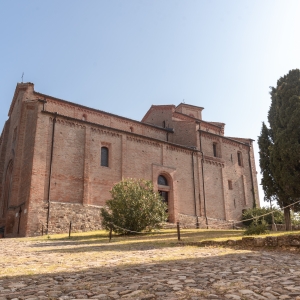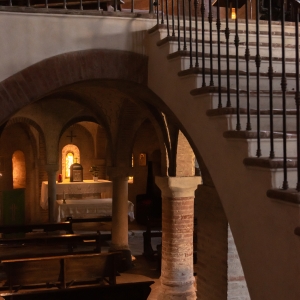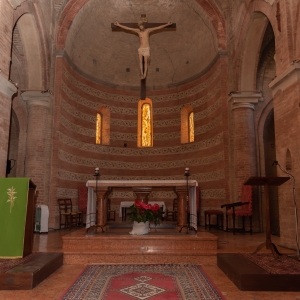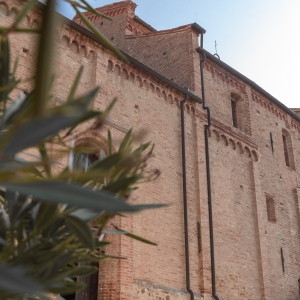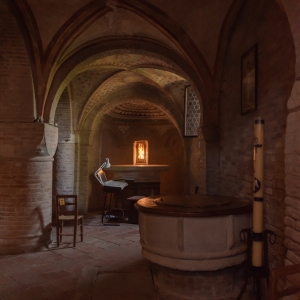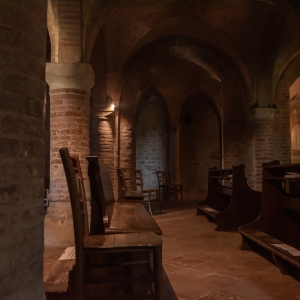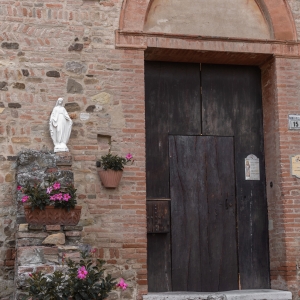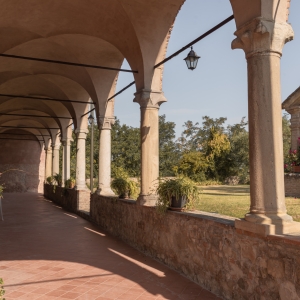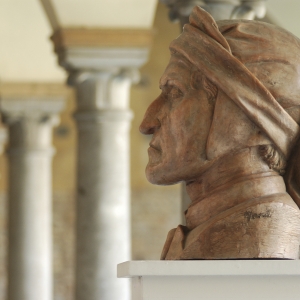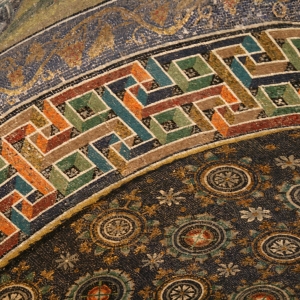EVENT OUT OF TIME
Abbey of Monteveglio
Comune di Valsamoggia
Events may vary, always contact the organizers before going on site.
BOOK NOW
In context of the "Monasteri Aperti" we offer a guieded tour of the hamlet and Abbey of Monteveglio. Walking you're going to discover that this area was once owned by the countess Matilde di Canossa.
Continuing along the road that crosses the hamlet, you will see the church, dedicated to Santa Maria Assunta, whose origins are very ancient. The church was built in the 1400s, but the current structure date back to the period between the 11th and 12th centuries. The entire complex was restored between 1925 and 1934 by the architect Giuseppe Rivani. The church has a presbytery with three naves, which rises above the crypt. The holy water stoup, located in the right aisle, is from the Lombard period. Accessing the presbitery, in the central nave there is a baroque-style staircase. The altar has five columns and is made of red Verona marble. On the sides of the presbytery there is a wooden structure that houses the choir. In the crypt, placed in the center of the church, there is a tombstone. The area is divided into four bays of columns and pillars with three altars placed in the three apses.
The monastic complex develops around the church.
As soon as it was erected, the monastery was assigned to the Regular Canons of San Frediano di Lucca, an ancient monastic congregation of Augustinian born around 556. The Regular Canons of San Frediano di Lucca arrived in Monteveglio between 1092 and 1100 and remained approximately until 1450. After 1455 the abbey was entrusted to the Lateran Canons of San Giovanni in Monte di Bologna. The Lateran Canons embellished these places with new furnishings and decorations, including a painting by Lorenzo Costa depicting the Assumption, now preserved at the National Gallery (Pinacoteca Nazionale) of Bologna.
In the following centuries the monastery acquired a notable economic prosperity. In the second half of the 20th century the abbey was, for a short time, inhabited by the community of Don Giuseppe Dossetti, a religious and political figure of great historical importance. Today, the abbey is inhabited by the Franciscans of the order of Fratelli di San Francesco.
Continuing along the road that crosses the hamlet, you will see the church, dedicated to Santa Maria Assunta, whose origins are very ancient. The church was built in the 1400s, but the current structure date back to the period between the 11th and 12th centuries. The entire complex was restored between 1925 and 1934 by the architect Giuseppe Rivani. The church has a presbytery with three naves, which rises above the crypt. The holy water stoup, located in the right aisle, is from the Lombard period. Accessing the presbitery, in the central nave there is a baroque-style staircase. The altar has five columns and is made of red Verona marble. On the sides of the presbytery there is a wooden structure that houses the choir. In the crypt, placed in the center of the church, there is a tombstone. The area is divided into four bays of columns and pillars with three altars placed in the three apses.
The monastic complex develops around the church.
As soon as it was erected, the monastery was assigned to the Regular Canons of San Frediano di Lucca, an ancient monastic congregation of Augustinian born around 556. The Regular Canons of San Frediano di Lucca arrived in Monteveglio between 1092 and 1100 and remained approximately until 1450. After 1455 the abbey was entrusted to the Lateran Canons of San Giovanni in Monte di Bologna. The Lateran Canons embellished these places with new furnishings and decorations, including a painting by Lorenzo Costa depicting the Assumption, now preserved at the National Gallery (Pinacoteca Nazionale) of Bologna.
In the following centuries the monastery acquired a notable economic prosperity. In the second half of the 20th century the abbey was, for a short time, inhabited by the community of Don Giuseppe Dossetti, a religious and political figure of great historical importance. Today, the abbey is inhabited by the Franciscans of the order of Fratelli di San Francesco.
free
DAYS & HOUR
| Ottobre-2023 | ||||||
| Lun | Mar | Mer | Gio | Ven | Sab | Dom |
| 25 | 26 | 27 | 28 | 29 | 30 | 01 |
| 02 | 03 | 04 | 05 | 06 | 07 | 08 |
| 09 | 10 | 11 | 12 | 13 | 14 | 15 |
| 16 | 17 | 18 | 19 | 20 | 21 | 22 |
| 23 | 24 | 25 | 26 | 27 | 28 | 29 |
| 30 | 31 | 01 | 02 | 03 | 04 | 05 |
INFO & TICKETS
Ente di gestione per i Parchi e la Biodiversità – Emilia Orientale
320/4607940

